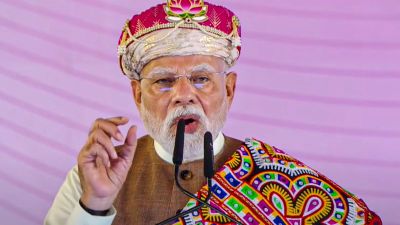‘Empowerment of SC/STs is still incomplete & reservations have to continue’
• Implementing job quota in the private sector is a sure way to bringing good companies down and to preventing good from getting better...

• Implementing job quota in the private sector is a sure way to bringing good companies down and to preventing good from getting better.
Raj
There is a misconception that the Scheduled Castes and Scheduled Tribes are inferior in terms of their intellect, education and skills. Only when this concept is given up can the Scheduled Castes and Scheduled Tribes be better integrated in the workforce and contribute their best. This is a problem of mindset.
• Doesn’t reserving seats/jobs on the basis of listed castes fail to serve the purpose? Shouldn’t the state offer help on the basis of economic backwardness regardless of caste?
J M Manchanda
At the outset, you may like to know that one of the criteria for reservation in jobs for SCs is for those who have suffered from the practice of untouchability and extreme deprivation for thousands of years. These SCs were denied access to books, schools and public places. After Independence, reservation on the basis of listed castes has helped in the development of those who are socially backward. In fact, caste is an important indicator of the overall social backwardness of a person. In the current social scenario, providing facilities as positive discrimination to ensure equality and equality of opportunity is the best method.
Moreover, the criterion of economic backwardness has never lost its relevance in other programmes of education and economic development. A well-defined income criteria is fixed for scholarship schmes, loan schemes for self-employment, and rural development schemes.
• Reservation for SCs/STs was initially for 10 years only. But after each 10 years it is extended for purely political reasons, although knowing very well that only the creamy layer of these castes benefits. Now you want to have reservation in the private sector. This won’t help Dalits but only give you some political mileage in the short run.
Rajiv Ahuja
Reservation was initially for 10 years only in case of Parliament and assembly constituencies. There was never any no time limit in case of reservation in services. Political reservations are definitely political, and the same political considerations that were instrumental in providing these reservations continue to hold good. The empowerment of SC/STs is still incomplete and it is necessary that they continue to get political reservation.
It is not correct to think that only the elite among the SC/STs are getting the advantage of reservation. This is not true even in case of reservation in services. In case of central government services, for example, the prescribed quota of reservation has not yet been filled in Group A and Group B services.
• I am an NRI and have adopted a child from India. Why does our country discriminate against our citizens based on one’s faith for adoptions? We have one law for Hindus and a separate one for Christians, Jews and Parsis, who only get guardianship and not full parental rights. Secondly, when will the ban on international adoptions be lifted from Andhra Pradesh?
Ruby Nakka
Adoption laws are different for different faiths in India due to religious beliefs and tenets. Adoption under the Hindu Adoption and Maintenance Act, 1955, is possible for Hindus, Sikhs, Jains and Buddhists whereas Christians and Muslims can take guardianship of a child under the Guardians and Wards Act, 1890. The Juvenile Justice (Care and Protection of Children) Act, 2000, has facilitated the adoption of orphaned, abandoned, neglected and abused children by all faiths.
There is no such ban on international adoptions in the state of Andhra Pradesh. A few placement agencies that were earlier authorised to process cases of adoption have been de-recognised by CARA on account of irregularities in their functioning.
• CARA (Central Adoption Resource Agency) has a dual role. In addition to regulation and monitoring, CARA is also expected to promote adoption. It is seen that any negative incident results in CARA introducing procedures which lead to delay in a child’s adoption.
Shekhar Patil
CARA is functioning as a central authority in the matter of adoptions in India. The procedure of inter-country adoption is governed by revised guidelines for adoption of Indian children, 1995, which are on the basis of directions and observations of the Supreme Court. Efforts have been made to keep the procedure simple and to minimise delays at all levels so that the stay of children in institutions is as short as possible.
In recent times, there has been a change of attitude among Indian parents and more children are placed in domestic adoptions. This has been possible due to the awareness campaigns carried out by the Ministry of Social Justice and Empowerment, CARA and other associated agencies. However, adoption is a sensitive matter and agencies have to be certain that any decision regarding placement in adoption is in the best interest of the child.
• The issue of streetchildren in metros has not been dealt at all. It is often dismissed as a problem of floating population.
Yashpal
The problem is not being ignored as a floating population problem, as is evident from the scheme ‘An Integrated Programme for Streetchildren’, which is being implemented by the ministry across the country. Under the scheme, funds are provided for establishment of 24-hour drops in shelters for children, which offer facilities for night stay, bathing, toilets, first aid and recreation. Besides, the scheme supports programmes for formal and non-formal education and vocational training of such children. Funds are also being provided to voluntary organisations for childline projects under this scheme. Childline is a 24-hour toll-free service and any child in distress or an adult on his behalf can dial 1098 free of charge to receive necessary assistance.
• Every winter, the issue of night shelter comes up. These are few in number and even the existing ones provide only the minimum of facilities, especially to women.
Saroj
The issue of night shelters during winters is an important one, especially for the city of Delhi, which has a large migrant population and where winters are severe. The Government of NCT of Delhi has been making efforts in this area with the help of voluntary organisations. Twenty-one ‘Rain Baseras’ (rain shelters) are functional in the city, out of which 10 are run by the Municipal Corporation of Delhi (MCD) and 11 are run through NGOs. In order to supplement the capacity available in permanent structures, 13 tent-based shelters were also put up last year, three meant for women.
Photos


- 01
- 02
- 03
- 04
- 05





























